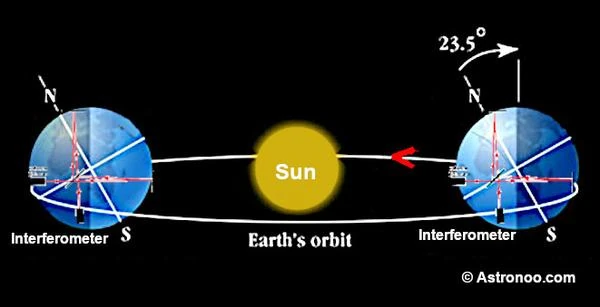
Image description: Michelson designed a device called an interferometer. This apparatus allows a beam of light to be split into two beams that travel in perpendicular directions. Reflected by mirrors and then recombined in the device, he expected to see interference fringes.
It was during the 19th century, with the works of Thomas Young (1773-1829), James Clerk Maxwell (1831-1879), and Heinrich Hertz (1857-1894), that the wave theory became the dominant model for describing light.
By the end of the 19th century, light was understood as an electromagnetic wave, and it was commonly accepted that, like any wave, it required a medium for propagation. This hypothetical medium was called the "luminiferous ether" or simply "ether."
The ether was supposed to be immobile and omnipresent, thus allowing light waves to propagate through space. Scientists believed that the Earth moved through this ether, and that this movement should affect the speed of light depending on the direction in which it traveled relative to the ether.
The objective of Albert Abraham Michelson (1852-1931) and Edward Morley (1838-1923) was to measure the variations in the speed of light depending on the direction of the Earth's movement relative to the ether. If the ether existed, it was expected that the speed of light would vary depending on the orientation of the experiment relative to the Earth's motion through this ether, due to the Doppler effect.
The Doppler effect is a physical phenomenon that occurs when a wave source (sound, light, etc.) moves relative to an observer. It results in an apparent variation in the frequency of the waves perceived by the observer, depending on the relative motion between the source and the observer.
To test this hypothesis, Michelson designed a device called an interferometer.
This device demonstrated the speed of light in its supposed medium, based on the classical law of velocity addition.
The apparatus split a beam of light into two beams traveling in perpendicular directions. These beams, reflected by mirrors and then recombined, were expected to show different speeds and thus interference fringes.
The basic principle is as follows: if the Earth, which has a speed of about 30 km/s relative to the Sun, is moving through the ether, the light beam traveling in the direction of the Earth's movement would not take the same time to cover a certain distance as the beam traveling perpendicularly. This time lag should result in a shift of the interference fringes when the apparatus is rotated by 90 degrees.
In other words, due to the Earth's movement through the ether, the speed of light should be different depending on the direction of propagation. This phenomenon, predicted by the wave theory of light, should induce a phase shift in the light rays and consequently a displacement of the interference fringes in Michelson's interferometer. If the ether exists, it should act like a "wind" that slows down the light moving in the same direction as the Earth. This slowdown should create an observable shift in the interferometer.
Imagine a swimmer trying to cross a river. If he swims perpendicularly to the current, he will reach the other side in a straight line, but the current will have slightly carried him downstream. If he swims with the current, he will move faster relative to the bank, but the distance he covers will be longer because he will be carried by the current.
The Earth, moving around the Sun, was thus "swimming" in this ether.
To everyone's surprise, the results of all the experiments between 1881 and 1887 were negative. No difference in speed was detected, regardless of the direction of the Earth's movement around the Sun. The interference fringes did not shift as expected in the presence of an ether.
The failure to detect the ether had major repercussions on theoretical physics. This result was one of the crucial pieces of evidence that led to the questioning of the existence of the ether and, subsequently, to the development of the theory of special relativity (1905) by Albert Einstein (1879-1955).
Special relativity eliminated the need for the ether by postulating that the speed of light in a vacuum is constant and independent of the movement of the source or the observer.
The Michelson-Morley experiment is often considered one of the most important experiments in the history of physics. It marked a decisive turning point in the abandonment of the ether theory and the adoption of special relativity, which radically transformed our understanding of fundamental concepts like space, time, and light.